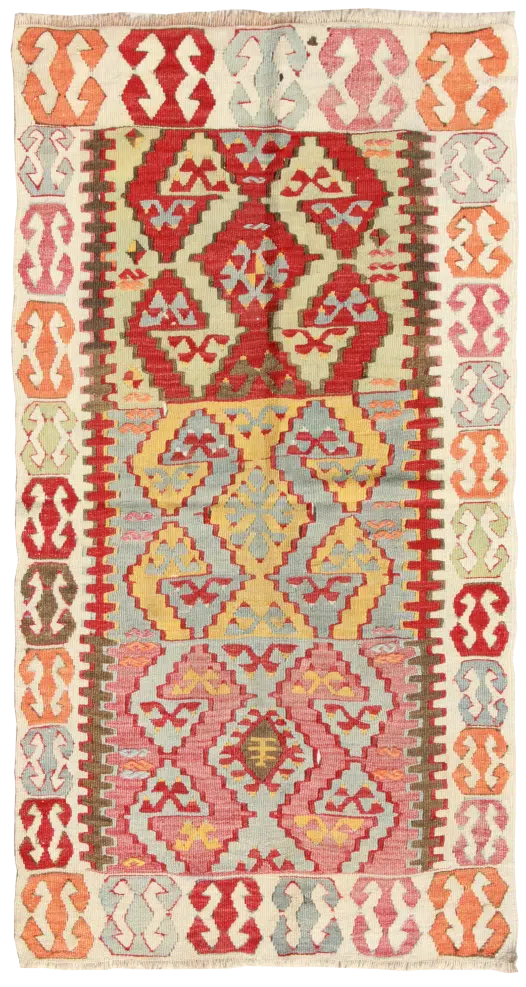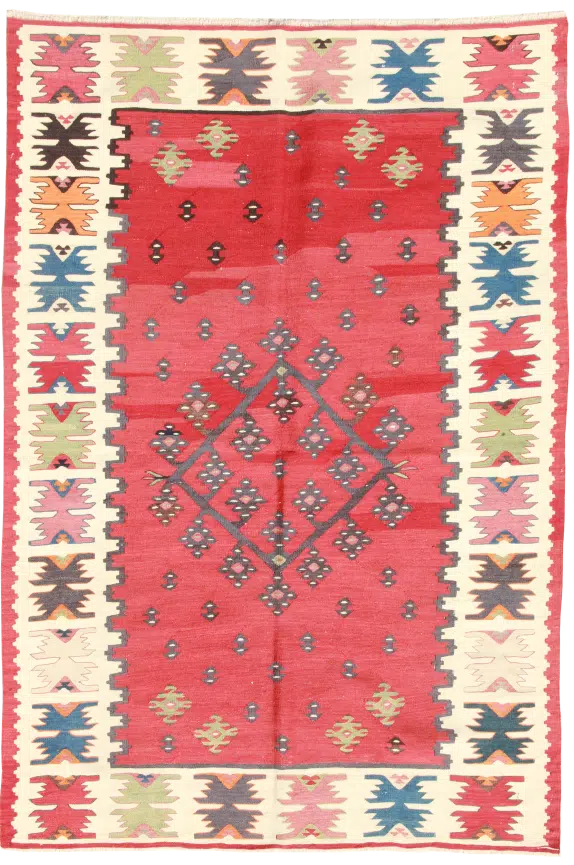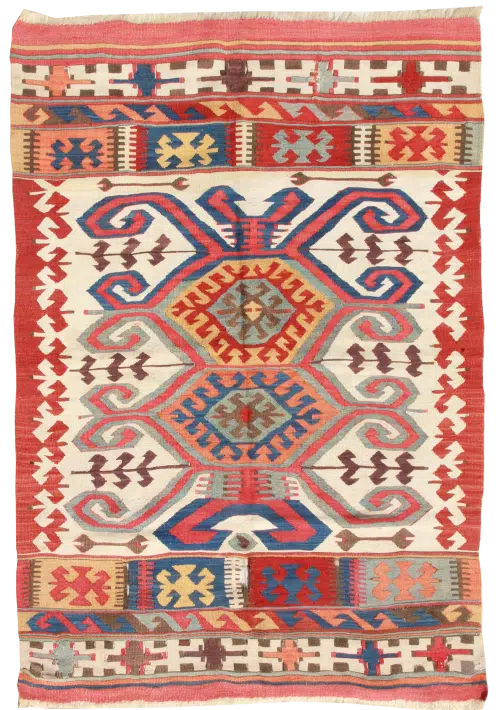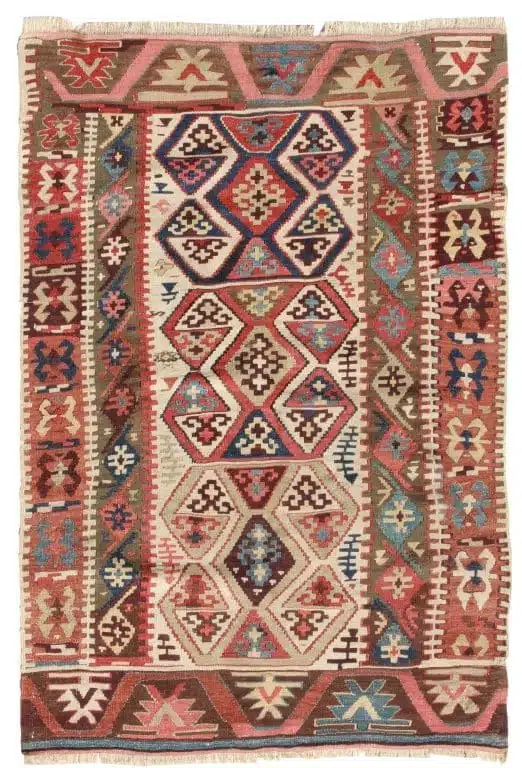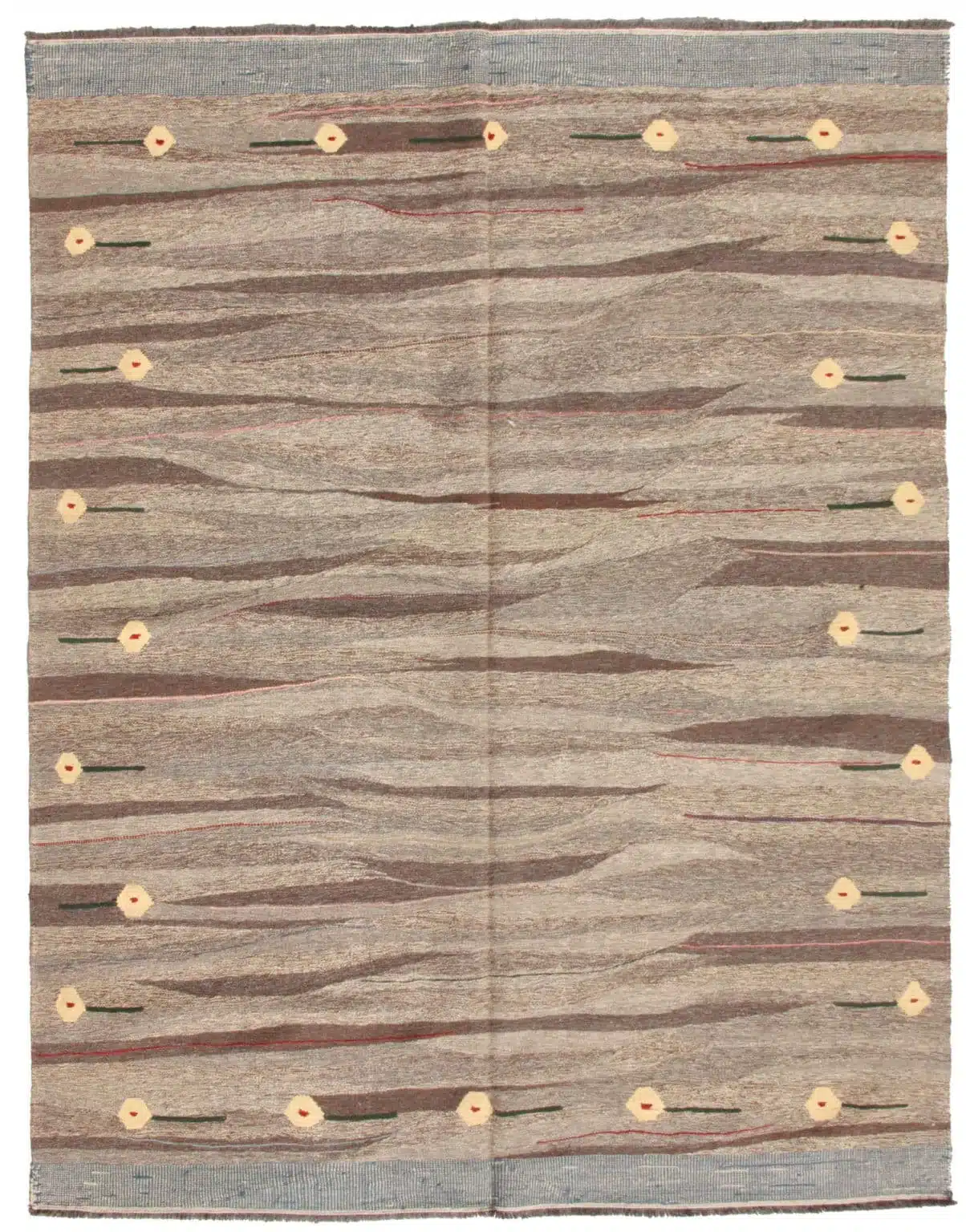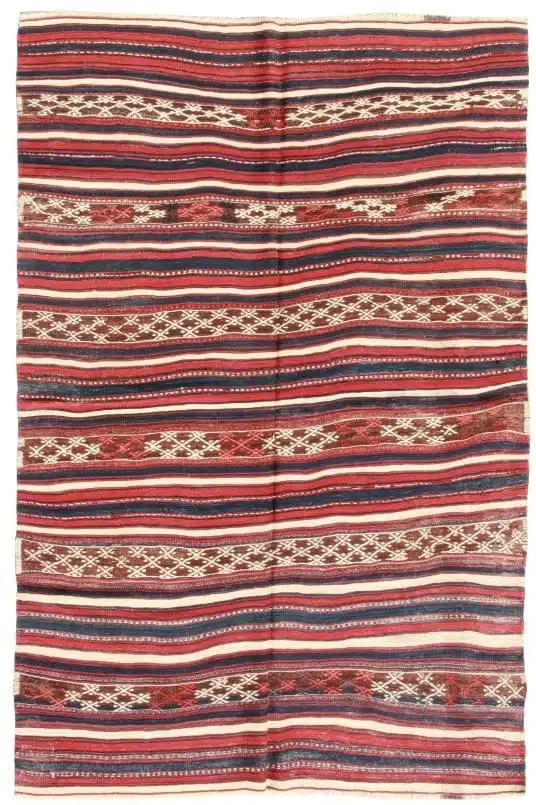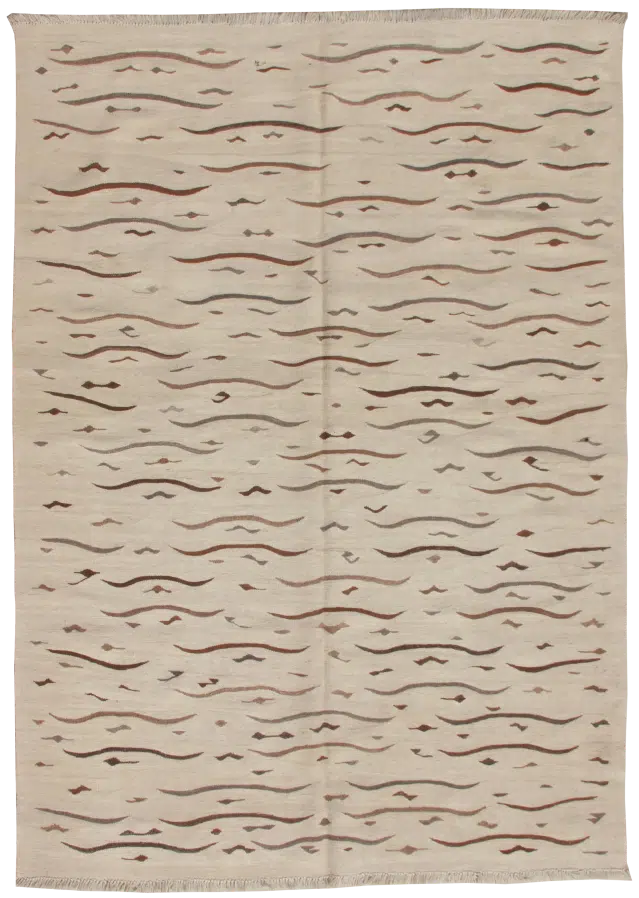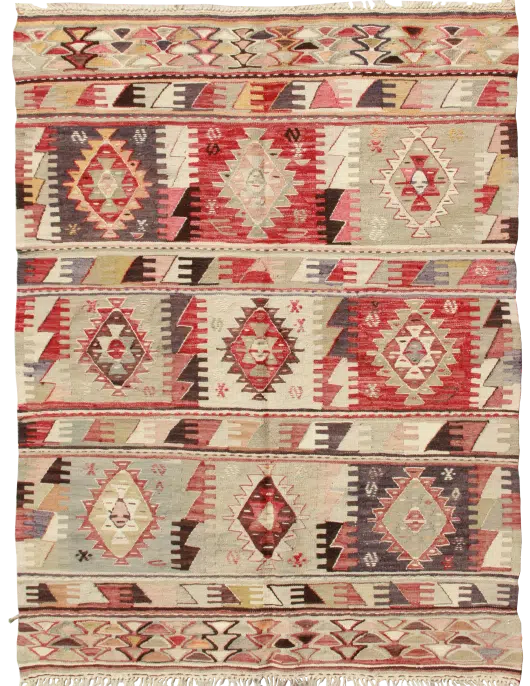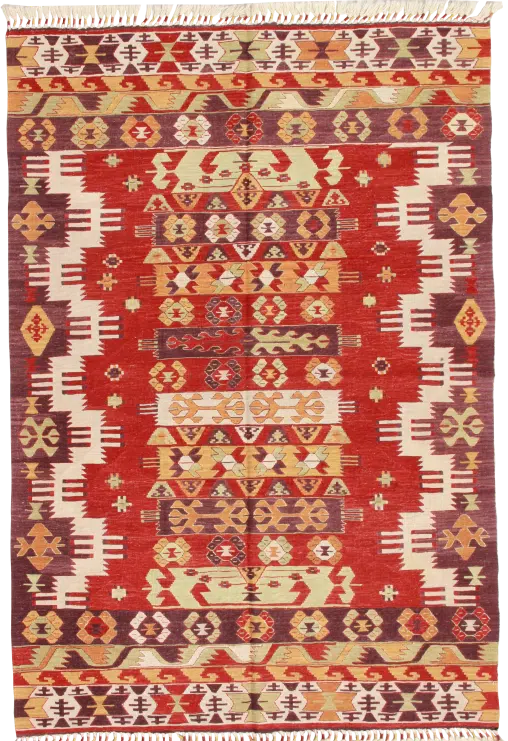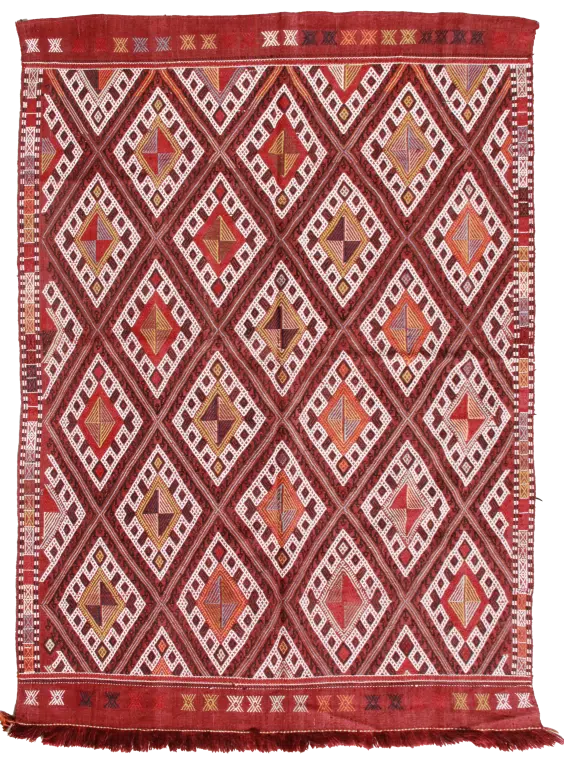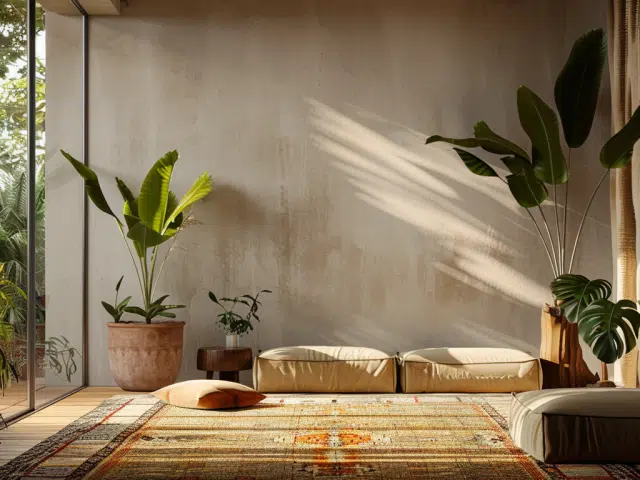Kilim Rugs
Kilims: A Unique Blend of Art and Craftsmanship
Kilims are a type of Turkish rug made from interweaving the warp and weft threads of different colors to result in a flat-weave. With no knots tied onto the weft tightly the warp, and no resulting pile, the rug is often thinner and softer, lays flatter and can be used as a cover or wall-hanging, as well as area rug. Typically, in the basic form of the flat-weave, the cotton or wool weft threads wrap tightly around the warp threads, creating blocks of solid color. These different blocks may be separated vertically or diagonally, creating the thin ‘slit’ we see at changes in color. More complex weaving techniques take a similar base, and adding different threads over the weft threads creates more detail, pattern and styles that reflect the region or tradition from which they come.
Characteristics of Kilim Rugs
Kilim rugs are typically made from wool, although they can also be made from other material as silk or cotton. The wool used in Kilim rugs is usually sourced from local sheep and goats, and is hand-spun into yarn. The yarn is then dyed using natural dyes made from plants, insects, and minerals, resulting in a wide range of vibrant colors.
Kilim rugs are created using a flat-weaving technique, which involves weaving the yarn back and forth across the carpet using warp threads. Unlike traditional rugs, which have a pile or tufted surface, Kilim rugs have a smooth surface. This gives them a distinctive look and texture that is prized by collectors and homeowners alike.
Kilim rugs are also known for their bold geometric patterns and designs. These patterns are often inspired by tribal and nomadic motifs, and can range from simple stripes and dots to detailed geometric shapes and floral motifs.
Turkish kilims and flat-weaves contain a wide range of colors and motifs, similar to traditional knotted Turkish rugs. The full range of symbols, from ‘hands-on-hips’ (elibelinde) to ‘ram’s horn’ and ‘tree of life’ are quite commonly seen on kilims and flat-weaves. While the method of weaving creates challenges of its own in forming the design and motifs, Turkish kilims can have quite detailed floral and animal designs, in addition to the familiar geometric shapes and patterns.
Nakkaş Kilim Collection
We have selected a few of our favorite rugs for display on here on our website, but we have many more kilims and flat-weaves, from bags to pillows to runners to door surrounds to wall hangings in our inventory.
Types of Kilim Rugs in Nakkas Collection
Esme kilims come from the town of Esme, in the Usak region of Anatolia. Made of wool and cotton, Esme kilims are unique to modern kilims in their use of soft pastel colors and pale wool. Each kilim tells a story through its use of color and pattern. Green symbolizes a wish, blue means hope and purple signifies grief in Esme kilims.
Elmadag kilims originate in the central northern part of Anatolia, near Ankara. The rich, dark colors of antique kilims are typical of this area. This lovely piece shows a detail in the center of ‘tuylu’, weaving longer loose strands into the tight warp threads to create a small decorative puff or flower across the center of the rug.
Gumurgen kilims come from the village of Gumurgen, in the Kayseri province in central Anatolia. The exuberant piece we have showcases how their bright colors, sharp patterns and tightly woven geometric designs fill every centimeter of this kilim.
Sarkoy kilims and flat-weaves originate in design and production from the Balkans, and the term now includes kilim production in Bulgaria, Greece and areas in north-west Turkey near the borders with those countries.
Sivri Hisar kilims come from an area west of Ankara. They are known for their stacked chimney forms. Our lovely piece is a prayer rug with stylized eli belinde and a row of chimney figures at the top.
Types of Antique Kilim Rugs
There are several different types of Kilim rugs, each with its own unique characteristics. Tribal Kilims are made by nomadic tribes and are typically smaller in size and simpler in design. Village Kilims are made by settled communities and are often larger and more complex in design. City Kilims, on the other hand, are made in urban centers and are typically the largest and most intricate of all Kilim rugs.
Buying a Kilim Rug
When buying a Kilim rug, there are several factors to consider. The size of the rug is important, as it should be proportional to the size of the room. The pattern and color of the rug should also be taken into account, as they can have a significant impact on the overall look and feel of the space.
To find an authentic Kilim rug, it's important to look for certain characteristics. For example, authentic Kilim rugs are usually made from wool and dyed using natural dyes. They may also have slight imperfections, such as variations in hair color or irregularities in the weave.
The sale price of a Kilim rug can vary depending on several factors, such as the size, quality, and rarity of the rug. However, it's important to keep in mind that Kilim rugs are an investment, and a high-quality rug can last for many years with proper care.
Kilim Rug Collection at Nakkaş
Kilim rugs are a unique blend of art and craftsmanship, prized for their vibrant colors, bold patterns, and exceptional quality. Whether you’re looking to add a touch of warmth to your home decor or to create a statement piece, a Kilim rug is a perfect choice. With their rich history and stunning craftsmanship, Kilim rugs are more than just floor coverings – they are works of art that can be cherished for generations to come. By taking the time to choose the right Kilim rug for your home and caring for it properly, you can enjoy its beauty and durability for years to come.
To keep a Kilim rug looking its best, it’s important to clean and maintain it properly. Regular vacuuming can help remove dust and dirt from the rug’s surface, while spot-cleaning with a mild detergent can help remove stains. Kilim rugs should also be rotated periodically to ensure even wear and tear.
If a Kilim rug becomes damaged, it’s important to address the problem as soon as possible. A professional rug cleaner can help repair holes, tears, and other types of damage, ensuring that the rug stays in excellent condition for many years to come.
At Nakkaş Rug Store, our weavers are proud to offer a wide selection of Kilim rugs, each one hand-selected for its quality and beauty. Our knowledgeable staff can help you find the perfect Kilim rug for your home, and we also offer professional cleaning and repair services to ensure that your rug stays in excellent condition. Visit us today and discover the timeless beauty of Kilim rugs!
History and Origin of Kilim Rugs
The term “kilim” is derived from the Persian word “gelim,” which means “to spread roughly.” Believed to have been created as early as the 5th century BC, kilim rugs were initially produced by nomadic tribes in countries like Turkey, Iran, Afghanistan, and the Caucasus region. The rugs served various purposes, from providing insulation and floor coverings in tents to being used as prayer mats and saddlebags.
Kilim’s timeless appeal, durability, and versatility make them a favorite choice for homeowners and designers alike. As you explore the world of kilim rugs, you will discover a rich tapestry of history, skill, and tradition woven into every piece.
Kilim rugs are made using a unique weaving technique called “slitweave” or “flatweave,” which involves interweaving colored threads vertically (the weft) and horizontally (the warp) to create a tightly-knit, flat surface. This method is distinct from the traditional knotted technique used in other rug types, making kilims lighter, thinner, and more pliable.
The materials used to create kilim rugs are primarily natural fibers, including wool, cotton, and sometimes silk. The dyes for the fibers are typically derived from natural sources, such as plants, minerals, and insects, resulting in vibrant and long-lasting colors.
Kilim rugs are known for their bold geometric patterns and intricate designs, which often have symbolic meaning. Common motifs include diamonds, zigzags, crosses, and medallions, each representing different aspects of tribal life, such as fertility, protection, and prosperity. Additionally, the rugs may showcase unique tribal or regional characteristics, as each weaving community has its own distinct style.
Kilim rugs are also available in a wide range of colors, from earthy tones like brown, rust, and beige to vibrant hues like red, blue, and green. The color palette often reflects the local landscape, as well as the resources available to the weavers.

